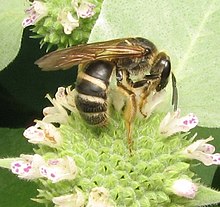Lasioglossum
| Lasioglossum | |
|---|---|
 |
|
| Scientific classification | |
| Kingdom: | Animalia |
| Phylum: | Arthropoda |
| Class: | Insecta |
| Order: | Hymenoptera |
| Family: | Halictidae |
| Subfamily: | Halictinae |
| Tribe: | Halictini |
| Genus: |
Lasioglossum Curtis, 1833 |
| Subgenera | |
|
see text |
|
see text
The sweat bee genus Lasioglossum is the largest of all bee genera, containing over 1700 species in numerous subgenera worldwide. They are highly variable in size, coloration, and sculpture; among the more unusual variants, some are cleptoparasites, some are nocturnal, and some are oligolectic. Most Lasioglossum nest in the ground, but some species nest in rotten logs.
The genus Lasioglossum can be divided into two informal series based on the strength of the distal veins of the forewing. The Lasioglossum series (or strong-veined Lasioglossum) is mostly composed of solitary or communal species. Two possible exceptions are L. aegyptiellum and L. rubricaude, both of which show signs of division of labour indicative of eusociality.
The Hemihalictus series (or weak-veined Lasioglossum) includes species with a wide range of sociality. The Hemihalictus series is composed of species which are solitary, communal, semisocial, primitively eusocial, cleptoparasitic, or socially parasitic. Eusocial species may have small colonies with only one or a few workers or large colonies with dozens of workers. The largest colony sizes occur in L. marginatum, which forms perennial colonies lasting five or six years, with hundreds of workers.
A list of subgenera (modified from Michener's Bees of the World):
Lasioglossum series: Australictus, Callalictus, Chilalictus, Ctenonomia, Echthralictus, Glossalictus, Homalictus, Lasioglossum s. str., Leuchalictus, Oxyhalictus, Parasphecodes, Pseudochilalictus, Rubrihalictus, Urohalictus.
Hemihalictus series: Acanthalictus, Austevylaeus, Dialictus, Evylaeus, Hemihalictus, Paradialictus, Sellalictus, Sphecodogastra, Sudila.
Subgeneric classification of Lasioglossum remains controversial, with disagreement among experts on the number and extent of subgenera.
Two of the better-known species are the European Lasioglossum malachurum and the North American species Lasioglossum zephyrum.
...
Wikipedia
